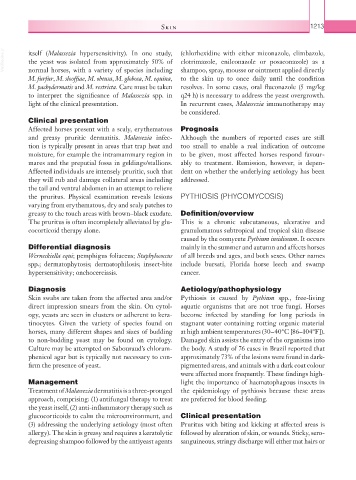Page 1238 - Equine Clinical Medicine, Surgery and Reproduction, 2nd Edition
P. 1238
Skin 1213
VetBooks.ir itself (Malassezia hypersensitivity). In one study, (chlorhexidine with either miconazole, climbazole,
clotrimazole, enilconazole or posaconazole) as a
the yeast was isolated from approximately 50% of
normal horses, with a variety of species including
to the skin up to once daily until the condition
M. furfur, M. slooffiae, M. obtusa, M. globosa, M. equina, shampoo, spray, mousse or ointment applied directly
M. pachydermatis and M. restricta. Care must be taken resolves. In some cases, oral fluconazole (5 mg/kg
to interpret the significance of Malassezia spp. in q24 h) is necessary to address the yeast overgrowth.
light of the clinical presentation. In recurrent cases, Malassezia immunotherapy may
be considered.
Clinical presentation
Affected horses present with a scaly, erythematous Prognosis
and greasy pruritic dermatitis. Malassezia infec- Although the numbers of reported cases are still
tion is typically present in areas that trap heat and too small to enable a real indication of outcome
moisture, for example the intramammary region in to be given, most affected horses respond favour-
mares and the preputial fossa in geldings/stallions. ably to treatment. Remission, however, is depen-
Affected individuals are intensely pruritic, such that dent on whether the underlying aetiology has been
they will rub and damage collateral areas including addressed.
the tail and ventral abdomen in an attempt to relieve
the pruritus. Physical examination reveals lesions PYTHIOSIS (PHYCOMYCOSIS)
varying from erythematous, dry and scaly patches to
greasy to the touch areas with brown–black exudate. Definition/overview
The pruritus is often incompletely alleviated by glu- This is a chronic subcutaneous, ulcerative and
cocorticoid therapy alone. granulomatous subtropical and tropical skin disease
caused by the oomycete Pythium insidiosum. It occurs
Differential diagnosis mainly in the summer and autumn and affects horses
Werneckiella equi; pemphigus foliaceus; Staphylococcus of all breeds and ages, and both sexes. Other names
spp.; dermatophytosis; dermatophilosis; insect-bite include bursati, Florida horse leech and swamp
hypersensitivity; onchocerciasis. cancer.
Diagnosis Aetiology/pathophysiology
Skin swabs are taken from the affected area and/or Pythiosis is caused by Pythium spp., free-living
direct impression smears from the skin. On cytol- aquatic organisms that are not true fungi. Horses
ogy, yeasts are seen in clusters or adherent to kera- become infected by standing for long periods in
tinocytes. Given the variety of species found on stagnant water containing rotting organic material
horses, many different shapes and sizes of budding at high ambient temperatures (30–40°C [86–104°F]).
to non-budding yeast may be found on cytology. Damaged skin assists the entry of the organisms into
Culture may be attempted on Sabouraud’s chloram- the body. A study of 76 cases in Brazil reported that
phenicol agar but is typically not necessary to con- approximately 73% of the lesions were found in dark-
firm the presence of yeast. pigmented areas, and animals with a dark coat colour
were affected more frequently. These findings high-
Management light the importance of haematophagous insects in
Treatment of Malassezia dermatitis is a three-pronged the epidemiology of pythiosis because these areas
approach, comprising: (1) antifungal therapy to treat are preferred for blood feeding.
the yeast itself, (2) anti-inflammatory therapy such as
glucocorticoids to calm the microenvironment, and Clinical presentation
(3) addressing the underlying aetiology (most often Pruritus with biting and kicking at affected areas is
allergy). The skin is greasy and requires a keratolytic followed by ulceration of skin, or wounds. Sticky, sero-
degreasing shampoo followed by the antiyeast agents sanguineous, stringy discharge will either mat hairs or

